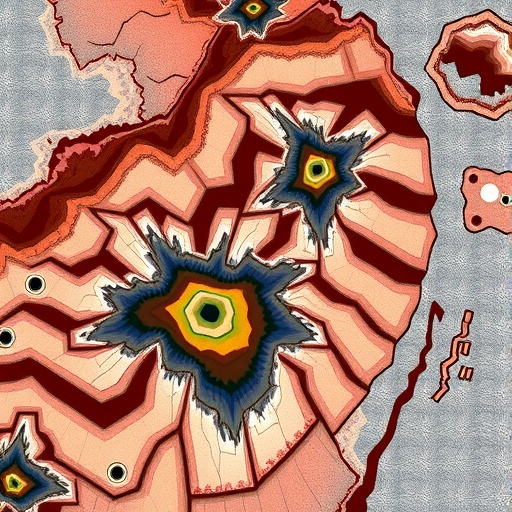In recent studies, the intricate and often overlooked processes governing mineral deposits have gained attention, particularly with respect to cobalt (Co) mineralization in skarn-type deposits. An insightful numerical modeling case study focused on the Zhuchong deposit located in Anhui Province, China, sheds light on how cooling fronts impact the mineralization of cobalt within iron-rich deposits. This research, conducted by a team of experts including Hu, Liang, and Wang, has opened new avenues for understanding the complex interplay between geological processes and resource distribution.
Cobalt, an essential metal used predominantly in batteries, superalloys, and catalytic processes, is increasingly being recognized for its strategic importance in various high-tech applications. The Zhuchong deposit, noted for its rich cobalt and iron content, provides an excellent opportunity to explore the mineralization mechanisms through sophisticated numerical models. The study delves deep into the role of cooling fronts, which can significantly influence the thermal dynamics and resulting mineral compositions within these deposits.
At the core of the research lies the concept of skarn deposits, which form at the interface between intrusive igneous rocks and sedimentary sequences. This geological setting is crucial because it dictates the availability of essential elements and the subsequent mineralization process. The authors have utilized numerical modeling to simulate the temperature profiles and chemical interactions occurring within the skarn, allowing for a more robust understanding of mineral deposition under varying thermal conditions.
One of the key findings of this research is the effect of cooling rates on mineral crystallization, which plays a fundamental role in determining which minerals will form and in what quantities. As magma cools, the solubility of various elements changes, leading to the precipitation of different minerals over time. By carefully calibrating their model to mimic the geological conditions of the Zhuchong deposit, the researchers were able to ascertain optimal conditions for cobalt mineralization, revealing specific temperature thresholds that favor its deposition.
Moreover, the team explored the geochemical gradients that emerge from these cooling processes, noting that as the temperature drops, there is a transition in the types of minerals that crystallize. This transition is not only driven by the cooling front but also influenced by the fluid compositions interacting with the solid phases. The intricate dance between these factors reveals why certain areas within the deposit may be richer in cobalt, providing a framework for resource exploration and extraction strategies.
The insights gained from this study are not just academically significant; they have real-world implications for mineral exploration targeting cobalt-rich deposits. Understanding the thermal profiles and mineralogies that influence cobalt distribution can guide mining companies in their exploration efforts, optimizing the chances of striking economically viable quantities of minerals. In a world increasingly leaning towards renewable energy and electric vehicles, cobalt’s role is set to become even more critical as demand escalates.
While the primary focus remains on cobalt, the study does not ignore the interconnectedness of other metals within skarn-type deposits. The numerical model provides a comprehensive view that includes the distribution of iron and its relationship with cobalt mineralization. This holistic approach to analyzing mineral deposits could parallel other high-stakes resources, paving the way for broader applications of such modeling techniques in mineral exploration.
The research team has made their modeling outputs accessible, allowing further validation and investigation by the global scientific community. This collaborative spirit fosters a more significant amount of peer engagement and opens up discussions on refining these models to incorporate additional variables, such as tectonic activities or the impacts of climate over geological timescales, which may also play a part in mineral deposit formation.
It is also noteworthy that this study highlights the necessity of innovation in mineral exploration practices. As traditional mining techniques may result in inefficient extraction or overlook valuable resources, employing advanced modeling tools can significantly enhance the efficiency and efficacy with which resources are identified and exploited, marrying geology with technology seamlessly.
As businesses and governments invest in sustainable practices, the results from this study could form the foundation of a new paradigm in mining operations—one that prioritizes efficiency and responsibility while meeting the growing needs of a technologically driven world.
Carefully evaluating the findings and methodologies laid out by Hu and their colleagues can further solidify the connection between academic research and practical application in mining. As industries strive to fulfill environmental and economic goals, studies that elucidate the mechanics of mineral formation and distribution are more valuable than ever.
In conclusion, the modeling of temperature impacts on cobalt mineralization in the Zhuchong deposit presents a paradigm shift in how geologists may approach mineral exploration. The combination of advanced numerical modeling with geological principles offers a pathway to more responsibly harness the Earth’s resources while meeting the demands of modern society. The work of Hu, Liang, and Wang serves as a benchmark in the field and provides a template for future research that may continue to unravel the complexities of mineral deposits lurking beneath our feet.
Subject of Research: The impact of cooling fronts on cobalt mineralization within skarn-type deposits.
Article Title: Cooling Front Controls on Co Mineralization within Skarn-Type Co-Rich Fe Deposits: A Numerical Modeling Case Study of the Zhuchong Deposit, Anhui Province, China.
Article References: Hu, X., Liang, X., Wang, F. et al. Cooling Front Controls on Co Mineralization within Skarn-Type Co-Rich Fe Deposits: A Numerical Modeling Case Study of the Zhuchong Deposit, Anhui Province, China. Nat Resour Res (2025). https://doi.org/10.1007/s11053-025-10573-z
Image Credits: AI Generated
DOI: https://doi.org/10.1007/s11053-025-10573-z
Keywords: cobalt mineralization, skarn-type deposits, Zhuchong deposit, numerical modeling, cooling fronts, mineral exploration, thermal dynamics, geochemical gradients, resource distribution, mining practices.




